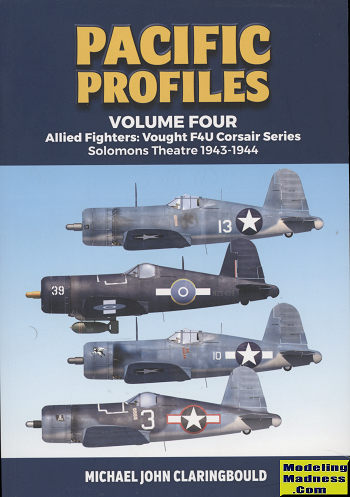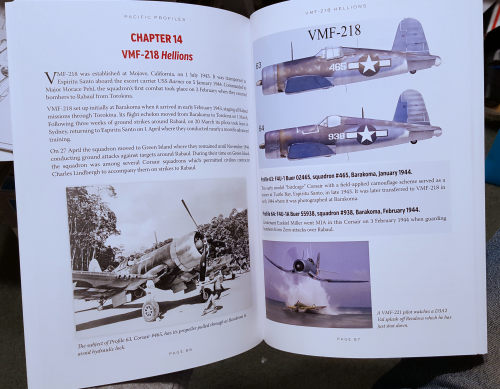 The
southwestern Pacific theater of operations was, for the Allies, a tough place to
conduct a war. Supply lines were long, the enemy was tenacious, and the
environment was very hard on both equipment and men. It was also where the F4U
Corsair was first used in combat. In fact, the plane was basically limited to
land base operations until quite late in 1944. This was for several reasons. One
is that it wasn't the easiest aircraft to land on a carrier deck. Not only was
it difficult to see over the long nose, but it had a tendency to 'bounce' when
it hit the deck. Another is that the F6F Hellcat was more than adequate to the
task and easier to fly and land on carriers. Add to it that carrying another
fighter type only added to the issues with supplies that had to be stocked
aboard ship and this as much as anything kept them from the flight deck until
late in the war. However, the Marines, who for the most part liked the plane,
had a chance to swap out their nearing-obsolescent F4F Wildcats for a plane with
much better overall performance.
The
southwestern Pacific theater of operations was, for the Allies, a tough place to
conduct a war. Supply lines were long, the enemy was tenacious, and the
environment was very hard on both equipment and men. It was also where the F4U
Corsair was first used in combat. In fact, the plane was basically limited to
land base operations until quite late in 1944. This was for several reasons. One
is that it wasn't the easiest aircraft to land on a carrier deck. Not only was
it difficult to see over the long nose, but it had a tendency to 'bounce' when
it hit the deck. Another is that the F6F Hellcat was more than adequate to the
task and easier to fly and land on carriers. Add to it that carrying another
fighter type only added to the issues with supplies that had to be stocked
aboard ship and this as much as anything kept them from the flight deck until
late in the war. However, the Marines, who for the most part liked the plane,
had a chance to swap out their nearing-obsolescent F4F Wildcats for a plane with
much better overall performance.
It was in the Solomons that the Corsair entered combat
in February of 1943 with VMF-124. Then there was a steady influx of units into
the theater with those squadrons rotating out leaving their planes for an
incoming squadron. That means that these planes saw a lot of hard service and
near the end of their useful life, very much looked like it. During this time
there were changes to the national insignia as well as changes to the paint
scheme. It is interesting for modelers to note that the 'intermediate blue' in
the tri-color camouflage scheme was basically the same 'upper surface blue-grey'
used when the Corsair was first built. In total, 18 USMC squadrons, two USN
squadrons and several RNZAF units flew the plane in the Solomons with several of
these units going on to other theaters as the war progressed.
 The book covers each of these squadrons
in greater or lesser detail,
showing each squadron's common markings and colors along with a number of great
photos and profiles based on those photos as you can see by the example provided
on the left. Each full color profile provides
information on that particular aircraft. No lengthy pilot stories or background
history on this as it concentrates on the aircraft and units involved in the
conflict. In addition to photos and profiles, you are provided an introductory
section on the plane and the theater of operations as well as some nice art
work, the latter spread throughout the book.
The book covers each of these squadrons
in greater or lesser detail,
showing each squadron's common markings and colors along with a number of great
photos and profiles based on those photos as you can see by the example provided
on the left. Each full color profile provides
information on that particular aircraft. No lengthy pilot stories or background
history on this as it concentrates on the aircraft and units involved in the
conflict. In addition to photos and profiles, you are provided an introductory
section on the plane and the theater of operations as well as some nice art
work, the latter spread throughout the book.
It all makes for a superb reference book for the modeler
and enthusiast. I very much like this series and look forward to each new
volume. Most highly recommended.
November 2021
Copyright ModelingMadness.com. All rights reserved. No
reproduction in part or in whole without express permission.
Review book courtesy of
Casemate Publishing. You can get your
copy from
this link.
If you would like your product reviewed fairly and quickly, please
contact the editor or see other details in the
Note to
Contributors.
 The
southwestern Pacific theater of operations was, for the Allies, a tough place to
conduct a war. Supply lines were long, the enemy was tenacious, and the
environment was very hard on both equipment and men. It was also where the F4U
Corsair was first used in combat. In fact, the plane was basically limited to
land base operations until quite late in 1944. This was for several reasons. One
is that it wasn't the easiest aircraft to land on a carrier deck. Not only was
it difficult to see over the long nose, but it had a tendency to 'bounce' when
it hit the deck. Another is that the F6F Hellcat was more than adequate to the
task and easier to fly and land on carriers. Add to it that carrying another
fighter type only added to the issues with supplies that had to be stocked
aboard ship and this as much as anything kept them from the flight deck until
late in the war. However, the Marines, who for the most part liked the plane,
had a chance to swap out their nearing-obsolescent F4F Wildcats for a plane with
much better overall performance.
The
southwestern Pacific theater of operations was, for the Allies, a tough place to
conduct a war. Supply lines were long, the enemy was tenacious, and the
environment was very hard on both equipment and men. It was also where the F4U
Corsair was first used in combat. In fact, the plane was basically limited to
land base operations until quite late in 1944. This was for several reasons. One
is that it wasn't the easiest aircraft to land on a carrier deck. Not only was
it difficult to see over the long nose, but it had a tendency to 'bounce' when
it hit the deck. Another is that the F6F Hellcat was more than adequate to the
task and easier to fly and land on carriers. Add to it that carrying another
fighter type only added to the issues with supplies that had to be stocked
aboard ship and this as much as anything kept them from the flight deck until
late in the war. However, the Marines, who for the most part liked the plane,
had a chance to swap out their nearing-obsolescent F4F Wildcats for a plane with
much better overall performance.  The book covers each of these squadrons
in greater or lesser detail,
showing each squadron's common markings and colors along with a number of great
photos and profiles based on those photos as you can see by the example provided
on the left. Each full color profile provides
information on that particular aircraft. No lengthy pilot stories or background
history on this as it concentrates on the aircraft and units involved in the
conflict. In addition to photos and profiles, you are provided an introductory
section on the plane and the theater of operations as well as some nice art
work, the latter spread throughout the book.
The book covers each of these squadrons
in greater or lesser detail,
showing each squadron's common markings and colors along with a number of great
photos and profiles based on those photos as you can see by the example provided
on the left. Each full color profile provides
information on that particular aircraft. No lengthy pilot stories or background
history on this as it concentrates on the aircraft and units involved in the
conflict. In addition to photos and profiles, you are provided an introductory
section on the plane and the theater of operations as well as some nice art
work, the latter spread throughout the book.